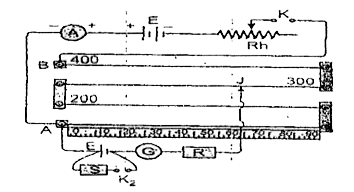What is the principle of a potentiometer? With the help pf circuit diagram, explain the use of potentiometer to measure internal resistance of a given primary cell.Solution in Punjabi
Principle of Potentiometer: To measure the internal resistance of a cell with the help of potentiometer: The arrangement for measuring the internal resistance (r ) of a cell using potentiometer is shown in the figure.

E= e.m.f of auxiliary battery
I= Constant current flowing through the potentiometer wire
Close to key by keeping the kye open. The jockey is moved over the potentiometer wire so as to balance the e.m.f (E ) of the cell, whose internal resistance (r ) is to be found. Let = Balancing length of potentiometer wire between point A and jockey J. At this stage, potential difference across A and J is equal to e.m.f (E ) of cell and galvanometer gives no deflection.
So
...(1)
Now close key so that the known resistance (R ) is connected across the cell. Find the balance point J., such taht on pressing the Jockey at J, galvanometer gives no deflection. At this stage, terminal potential difference (V) is equal to the potential difference across A and J.
If then
or ...(2)
Divide (1) by (2),
We know internal resistance
So by knowing the value of and R, we can find the internal resistance of cell.
Topper's Solved these Questions
- ELECTRICAL MEASUREMENTSBOOK - BETTER CHOICE PUBLICATIONCHAPTER - ELECTRICAL MEASUREMENTSEXERCISE - Long Answer Type Questions
7 Videos
- ELECTRICAL MEASUREMENTSBOOK - BETTER CHOICE PUBLICATIONCHAPTER - ELECTRICAL MEASUREMENTSEXERCISE - Numericals Problems
9 Videos
- ELECTRICAL MEASUREMENTSBOOK - BETTER CHOICE PUBLICATIONCHAPTER - ELECTRICAL MEASUREMENTSEXERCISE - Most Expected Questions
7 Videos
- ELECTRICAL DEVICESBOOK - BETTER CHOICE PUBLICATIONCHAPTER - ELECTRICAL DEVICESEXERCISE - (MOST EXPECTED QUESTIONS 2 MARK)
2 Videos
- ELECTROMAGNETIC INDUCTIONBOOK - BETTER CHOICE PUBLICATIONCHAPTER - ELECTROMAGNETIC INDUCTIONEXERCISE - NUMERICAL PROBLEMS
26 Videos
Similar Questions
State and explain Kirchhoff's laws.
View SolutionA cell of e.m.f. 1 V gives a balance point at 40 cm length of a potentioeter wire. For another cell, the balance point shifts to 60 cm. Find the e.m.f. of the second cell.
View SolutionWhy is a slide wire bridge also called a metre bridge?
View SolutionWhy the core of a transformer made of a magnetic material of high permeability?
View SolutionA magnetic field of 2×10−2T acts at right angles to a coil of area 100cm2 with 50 turns. The average e.m.f. induced in the coil is 0.1 V, When it is removed form the field in the time t. The value of t is
View SolutionState the principle of potentiometer. With the help of circuit diagram, describe a method to find the internal resistance of a primary cell.
View SolutionState the working principle of potentiometer explain with the help of circuit diagram how the emf of two primary cells are compared by using the potentiometer.
View SolutionState the working principle of potentiometer explain with the help of circuit diagram how the potentiometer is used to determine the internal resistance of the given primary cell.
View Solutionविभवमापी की सहायता से किसी प्राथमिक सेल का आंतरिक प्रतिरोध ज्ञात कीजिए|
View SolutionWrite the principle of working of a potentiometer. Describe briefly, with the help of a circuit diagram, how a potentiometer is used to determine the internal resistance of a cell.
View SolutionWrite the principle of working of a potentiometer. Describe briefly, with the help of circuit diagram, how a potentiometer is used to determine the internal resistance of a given cell.
View SolutionWrite the principle of working of a potentiometer. Describe briefly, with the help of a circuit diagram, how a potentiometer is used to determine the internal resistance of a given cell.
View SolutionState the principle of potentiometer. With the help of circuit diagram, describe a method to find the internal resistance of a primary cell.
View SolutionWhat is potentiometer? With the help of circuit diagram, explain how a potentiometer can be used to compare the emf of two primary cells.
View SolutionWhat is the principle of a potentiometer? With the help pf circuit diagram, explain the use of potentiometer to measure internal resistance of a given primary cell.
View Solution
